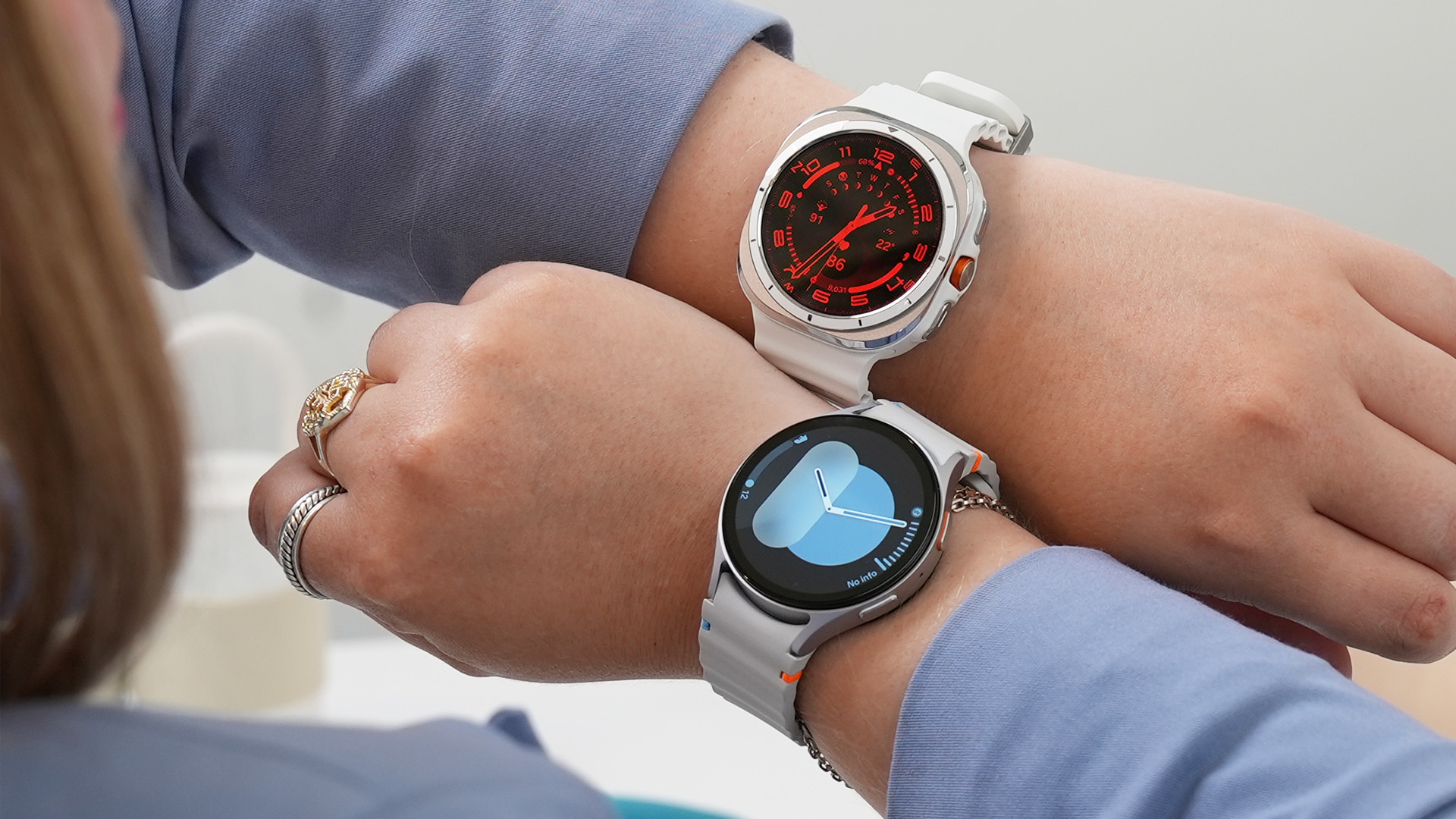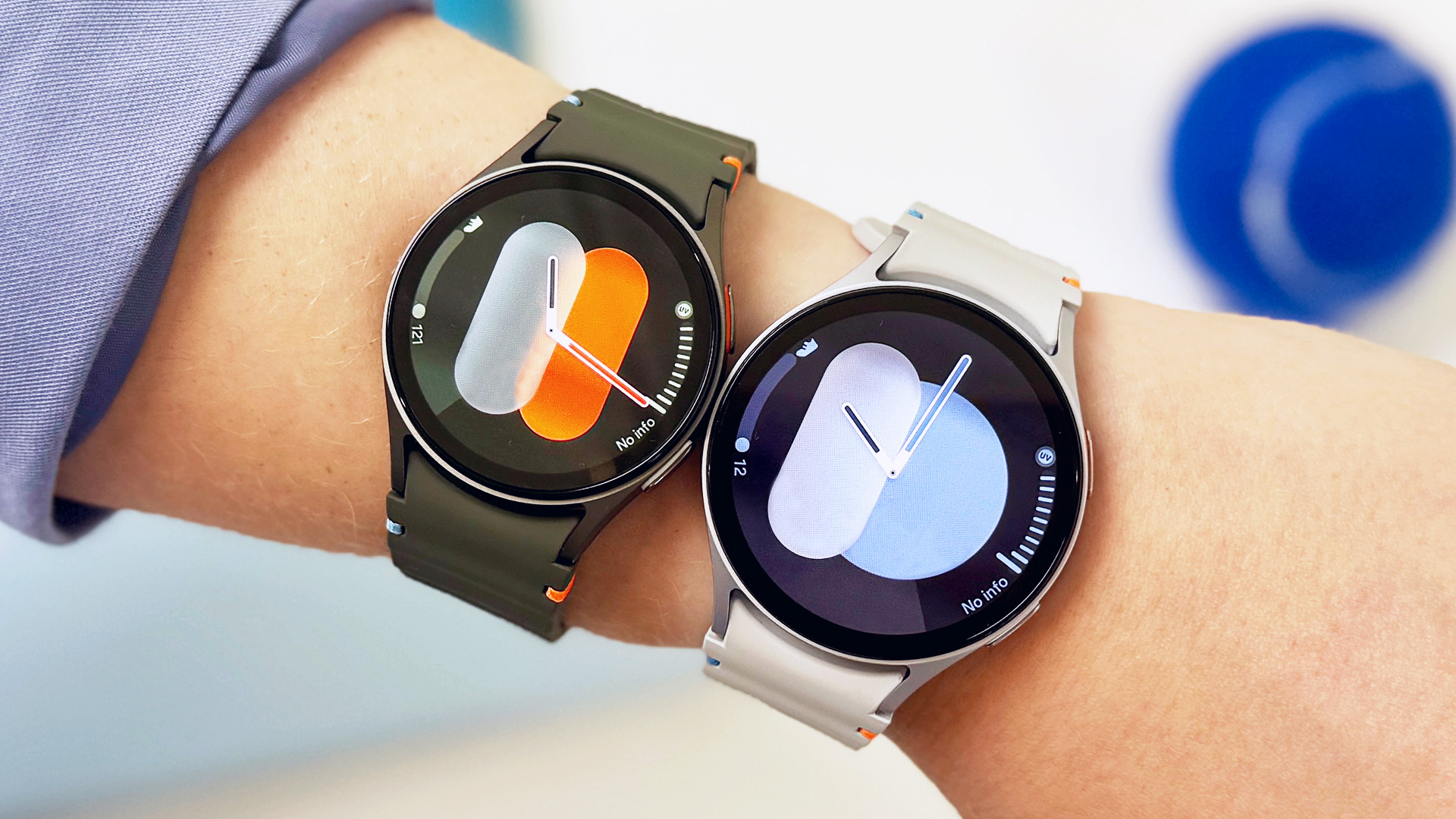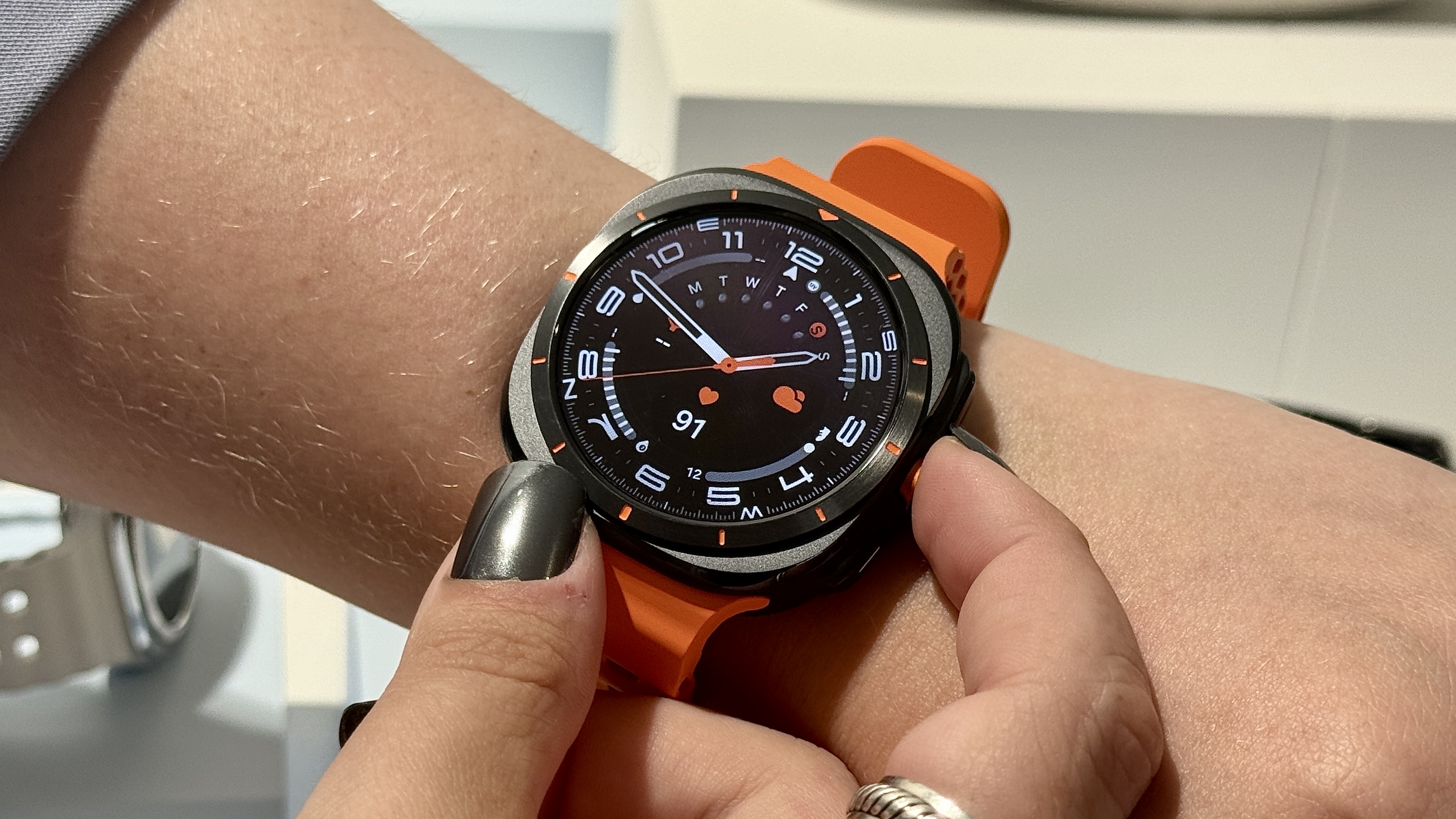Samsung Galaxy Watch 7 vs. Galaxy Watch Ultra: Biggest differences explained
Here's how the new Galaxy Watch 7 and premium Ultra compare

The new line of Samsung Galaxy smartwatches has arrived. Meet the Samsung Galaxy Watch 7 and premium Galaxy Watch Ultra. While the former looks virtually unchanged from the Galaxy Watch 6 before it, the latter represents a completely new aesthetic for Samsung.
There are more noteworthy differences between these two new devices aside from design, though. For one, the Galaxy Watch Ultra costs roughly double the Galaxy Watch 7. It also sports a beefier battery and better water resistance. And, while both boast impressive AI-backed health and fitness monitoring tech, including the latest BioActive health sensor, the Ultra offers more detailed training insights.
Here's a closer look at how the Samsung Galaxy Watch 7 and Galaxy Watch Ultra compare, tit for tat when it comes to price, build, features, battery life and outlook.
Samsung Galaxy Watch 7 vs. Ultra: Price and availability
Both the Samsung Galaxy Watch 7 and Galaxy Watch Ultra will be available for U.S. preorder from July 10 with availability expected on or before July 24.
The 7 comes in 40mm and 44mm with or without LTE connectivity. The Bluetooth-only 40mm model is $299.99 while the 44mm Bluetooth model is $329.99. Meanwhile, the 40mm LTE edition will cost you $349.99 while the larger LTE model is $379.99.
The Galaxy Watch Ultra starts at $649.99 for the Bluetooth model; add on another $50 for the LTE edition.
Samsung Galaxy Watch 7 vs. Ultra: Specs compared
| Header Cell - Column 0 | Galaxy Watch 7 | Galaxy Watch Ultra |
|---|---|---|
| Starting price | $299 | $649 |
| Sizes | 40mm, 44mm | 47mm |
| Colors | Green, Silver, Cream | Titanium White, Titanium Gray, Titanium Silver |
| Dimensions | 40mm: 40.4 x 9.7 mm; 44mm: 44.4 x 9.7 mm | 47.4 x 47. 1 x 12.1 mm |
| Weight | 40mm: 28.8 g; 44mm: 33.8 g | 60.5 g |
| Display | 40mm: 1.3" 432 x 432 ppi; 44mm: 1.5" 480 x 480 ppi | 1.5" 480 x 480 ppi |
| Battery capacity | 40mm: 300 mAh; 44mm: 425 mAh | 590 mAh |
| Durability | 5 ATM, IP68 | 10 ATM, IP68 |
| Connectivity | LTE (optional), Bluetooth 5.3, Wi-Fi 2.4+ 5 GHz, NFC | LTE (optional), Bluetooth 5.3, Wi-Fi 2.4+ 5 GHz, NFC |
| Compatibility | Android 11 or higher | Android 11 or higher |
| Storage | 32 GB | 32 GB |
| Processor | Exynos W1000 | Exynos W1000 |
| Sensors | Samsung BioActive sensor, temperature sensor, accelerometer | Samsung BioActive sensor, temperature sensor, accelerometer |
Samsung Galaxy Watch 7 vs. Ultra: Design

While the Galaxy Watch 7 stays faithful to Samsung's tried and true circular case design, the Ultra shakes things up in a delightful way with a more square-ish case. Samsung calls it the 'Cushion Case,' which I dig as it does resemble quite a few classic mechanical cushion case watches of yore.
The Galaxy Watch 7 sport an aluminum case while the Ultra boasts a Grade 4 titanium case, the highest strength unalloyed available. The former maintains 50 meters of water resistance while the Ultra ups the ante to 100 meters, matching that of the Apple Watch Ultra 2.

The Galaxy Watch Ultra also notably operates at a wider range of extreme altitudes than the 7, including 500 meters below sea level and 9,000 meters above, making it a tempting choice for extreme athletes and mountaineers. It also sports a customizable Quick Button, emergency siren and 3,000 nits of max screen brightness for easy viewing in bright sunlight.
Speaking of screens, the 40mm Galaxy Watch 7 has a 1.3-inch AMOLED display (432 x 432 pixels) while both the 44mm Galaxy Watch 7 and Galaxy Watch Ultra boast the same 1.5-inch AMOLED screen (480 x 480 pixels). All models feature a sapphire glass protective layer, which is tougher than synthetic options like Gorilla Glass.
The 40mm Galaxy Watch 7 comes in Green or Cream, the 44m is available in Green or Silver. The Ultra, meanwhile, is offered in White, Grey and Silver.
Samsung Galaxy Watch 7 vs. Ultra: Onboard tech
Both models have Samsung's latest BioActive wellness sensor which promises better accuracy across the board compared to past versions. This updated sensor array combines a PPG heart rate sensor, ECG sensor and blood oxygen reader with a new bioelectric impedance analysis (BIA) sensor that can read body composition.
Each new Galaxy smartwatch also sports an onboard temperature sensor, accelerometer, barometer, gyro sensor, geomagnetic sensor and light sensor.
You get the same Exynos W1000 processor, 2GB of memory and 32GB of storage no matter which model you choose. The latter is up from 16GB on the Galaxy Watch 6. These are also Samsung's first Galaxy Watch models with dual-frequency GPS antenna, for better location tracking, even in heavily wooded or urban areas.
Samsung Galaxy Watch 7 vs. Ultra: Wellness and fitness
With an emphasis on wellness, both the Galaxy Watch Ultra and Galaxy Watch 7 track a wide range of holistic metrics and workout data, providing insights, training tips and health monitoring alerts.
You can track over 100 exercise types with either device but only the Ultra keeps tabs on complex multi-sport activities, like triathlons. You also get more detailed training data from the Ultra. For instance, cyclists can learn their Functioning Threshold Power (FTP) in under five minutes. Ultra users also get personalized HR Zones.
Still, both devices offer useful training features like Race mode which lets you compare your current workout performance to past attempts to track progress over time. You can also view insights into body composition and monitor metabolic health by tracking Advanced glycation end products (AGEs). These provide an accurate snapshot of your current biological age and take into account diet and lifestyle habits.
Both devices additionally provide an AI-backed daily Energy Score, that takes into account all of your health, fitness and sleep data, along with daily wellness tips.
Sleep tracking is also a match between the 7 and Ultra. Plus, users get alerts for signs of sleep apnea, along with irregular heart rhythm notifications. You can also perform on-the-spot ECGs with either smartwatch.
Samsung Galaxy Watch 7 vs. Ultra: OS, Apps and features

The Galaxy Watch 7 and Ultra run the latest Wear OS 5 operating system, the first devices to do so, and have access to a wide range of native and third-party apps.
Plus, the NFC chips allows for contactless payments via Samsung Wallet. The watches also boast a new AI-backed 'Suggested Replies' feature to help you keep your adoring public better in the loop with minimal effort.
They also get Samsung's new Double Pinch Gesture which greatly expands what users can accomplish with one hand, similar to the Apple Watch's Double Tap motion. Notably, the Galaxy Ring also supports this new gesture, too.
Samsung Galaxy Watch 7 vs. Ultra: Battery life
According to Samsung, the Galaxy Watch Ultra offers 100 hours in Power Save mode and 48 in Exercise Power Save mode (with GPS), up from 40 hours on the Galaxy Watch 6.
The Galaxy Watch 7 should achieve 40 hours between charges, and the 40mm version sports a 300 mAh battery, with the larger 44mm model using a 435 mAh battery. We expect both sizes to provide battery life comparable to the Galaxy Watch 6. The Ultra, meanwhile has a whopping 590 mAh battery.
Samsung Galaxy Watch 7 vs. Ultra: Outlook
The Samsung Galaxy Watch Ultra is clearly positioned to go head-to-head with the Apple Watch Ultra line, while the Galaxy Watch 7 is a fairly iterative update to the Galaxy Watch 6 and more squarely in Apple Watch 9 and Google Pixel Watch 2 territory in terms of price and features.
Of course, all of the above-mentioned devices are due for a refresh in the coming weeks and months. So, hold on tight.
More from Tom's Guide
Sign up to get the BEST of Tom's Guide direct to your inbox.
Get instant access to breaking news, the hottest reviews, great deals and helpful tips.

Dan Bracaglia is the Tom’s Guide editorial lead for all things smartwatches, fitness trackers and outdoor gear. With 15 years of experience as a consumer technology journalist testing everything from Oura Rings to instant cameras, Dan is deeply passionate about helping readers save money and make informed purchasing decisions. In the past year alone, Dan has assessed major product releases from the likes of Apple, Garmin, Google, Samsung, Polar and many others.
An avid outdoor adventurer, Dan is based in the U.S. Pacific Northwest where he takes advantage of the beautiful surroundings every chance he gets. A lover of kayaking, hiking, swimming, biking, snowboarding and exploring, he also makes every effort to combine his day job with his passions. When not assessing the sleep tracking and heart rate accuracy of the latest tach gadgets, you can find him photographing Seattle’s vibrant underground music community.
